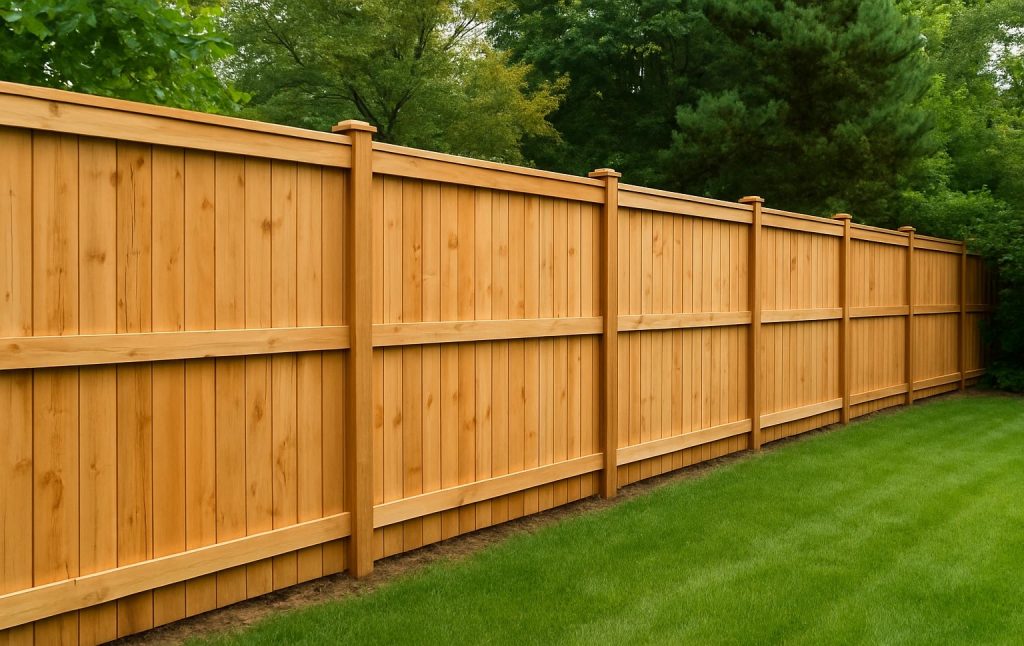Selecting High Quality Lumber for Fencing is essential for building a durable, elegant, and weather-resistant barrier. The wood you select determines how well your fence resists decay, pests, and extreme temperatures. Proper selection and treatment ensure that your investment lasts for decades while retaining its natural charm.
Understanding Wood Grades and Durability
Wood grading defines its quality, structural stability, and appearance. High-grade lumber features fewer knots, tighter grain, and better strength, making it ideal for fencing.
Cedar, redwood, and pressure-treated pine are some of the most popular species used in outdoor construction. Many wood fence Chicago IL projects rely on cedar for its natural oils that deter insects and rot. Its rich color and clean texture make it both durable and visually appealing.
For property owners who want minimal maintenance without losing aesthetics, Vinyl Fence Chicago offers an excellent alternative. Vinyl panels mimic the appearance of painted wood, resist fading, and require little upkeep—ideal for harsh weather conditions or busy commercial environments.
Moisture Control and Seasoning
The moisture content of lumber is critical to its long-term stability. Fresh-cut wood retains sap and water, which can lead to warping and cracking once installed. Kiln-dried wood, however, goes through a controlled process that removes internal moisture evenly, resulting in less deformation and longer life.
In Chicago’s mixed climate—cold winters, humid summers—properly dried wood ensures the fence won’t expand or contract excessively. It also absorbs sealants more effectively, giving the structure stronger protection against moisture and sunlight.
Pressure Treatment and Protective Coatings
Pressure-treated lumber provides one of the best defenses against decay and termites. Preservatives are forced deep into the fibers, shielding the wood from fungi and moisture.
When selecting treated lumber for fence posts or rails:
Confirm it’s rated for ground contact.
Reseal cut ends to maintain protection.
Use galvanized or stainless-steel nails to prevent rust.
Reapplying a protective coating every two or three years helps preserve both the fence’s appearance and durability.
Choosing the Right Wood for Local Conditions
Climate plays a huge role in material performance.
Humid climates: Cedar and redwood resist swelling and mold.
Cold regions: Pressure-treated pine withstands freeze–thaw cycles.
Dry environments: Hardwoods like oak and cypress resist cracking.
In Chicago, cedar remains the most balanced choice for its adaptability and cost-effectiveness. However, modern options like vinyl and steel fences are becoming increasingly popular for businesses seeking long-term, low-maintenance security.
Sustainability and Eco-Friendly Practices
Homeowners today value sustainability just as much as strength. Choosing lumber certified by the Forest Stewardship Council (FSC) ensures responsible forestry practices and renewable sourcing.
Vinyl fencing also supports eco-friendly design by reducing wood consumption and recycling manufacturing waste. These materials provide longevity without requiring frequent replacements or chemical treatments.
Environmentally conscious choices not only benefit the planet but also enhance property value by aligning with sustainable construction trends.
Integrating Modern Fence Designs
Modern fencing design often combines natural and industrial materials for style and endurance. A good example is pairing wood panels with metal framing or decorative accents.
Steel Fence Chicago has become a preferred option for many commercial properties because of its unmatched strength and low maintenance. When combined with wooden or vinyl sections, steel provides both structural stability and modern elegance.
Specialists from Chicago Commercial Fence frequently design these hybrid solutions—blending traditional craftsmanship with contemporary engineering to achieve fences that balance beauty and performance.
Maintenance Best Practices
Even the best materials need regular care to ensure longevity. A few simple maintenance habits can add years to your fence’s lifespan:
Annual inspection: Check for damaged boards, loose nails, or corrosion.
Seasonal cleaning: Remove dirt and mildew with gentle soap and water.
Resealing: Apply UV-resistant stain or sealer every few years.
Trimming vegetation: Prevent plants from holding moisture near the boards.
Consistent maintenance helps prevent rot, fading, and warping—keeping your fence looking and performing like new.
Advances in Wood Technology
Today’s lumber treatment techniques are more effective and environmentally friendly than ever before. Micro-pressure technology allows preservatives to penetrate deeper into the wood, providing stronger protection with fewer chemicals.
New sealants use plant-based oils and water-based formulas that maintain a natural appearance while shielding the surface from UV rays and moisture. These modern advancements help fences endure decades of exposure without losing their strength or color.
Cost and Long-Term Value
High-quality lumber may have a higher upfront cost, but it delivers significant savings over time. Durable wood requires fewer repairs, resists weathering better, and enhances property appeal.
For commercial properties, investing in strong materials ensures long-term security and reduces liability risks. A well-built fence made from premium materials becomes a valuable architectural feature that adds elegance, privacy, and function.
External Resource for Validation
For expert insights on wood performance, grading, and durability testing, refer to the U.S. Forest Service – Forest Products Laboratory (FPL). This research division provides authoritative data on sustainable wood usage and advanced preservation methods.
This credible resource enhances your post’s EEAT value and reinforces its technical accuracy with government-verified research.
Conclusion
Selecting high-quality lumber is more than just a design choice—it’s the foundation of strength and longevity. By considering factors like grain, moisture content, and sustainability, property owners can build fences that endure for decades.
Whether it’s the classic appeal of wood, the convenience of vinyl, or the toughness of steel, understanding material performance allows for smarter investments and long-term satisfaction. With professional installation and regular care, a well-built fence enhances both property value and peace of mind.

